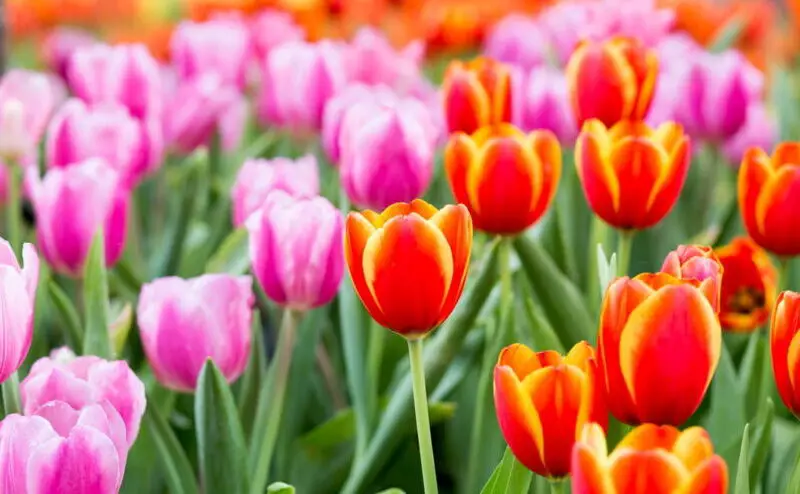Tulip bulbs should be left in the ground until they are mature, about 6 weeks after flowering. After that, it is best to harvest them and store them in a well-ventilated area before replanting in the fall.
Contents
Can tulips be replanted ?
Tulips themselves are not often replanted. It is the bulbs, which, after being stored in a fresh place, are put back in the ground to give again tulips. We have written an article on planting tulip bulbs.
To summarize quickly, tulip bulbs are planted with the tip up. They are buried 2 to 3 times their height. If you plant the bulb deeper, it is not serious in itself: it will come out a little later. On the other hand, it can be victim of the frost if it is not sufficiently buried.
What to do after the tulips bloom ?
To favour the new bloom of your tulips, some precautions are necessary from the first spring.
At the end of the season, cut off the faded flowers, do not cut the foliage before it turns yellow and dries naturally.
It is this foliage that allows the bulb, after flowering, to reconstitute its nutritive reserves and thus to prepare the next year’s flowering. If you cut the still green leaves, at the same time as the faded tulips, you leave in the ground a bulb emptied of its substance, unable to bloom again!
Let the foliage yellow naturally, even if it is not very aesthetic in the bed (plan to plant the tulip bulbs between perennials with ample foliage, perennial geraniums for example, which will mask the yellowing foliage) before cutting it at the base.
Pulling out bulbs, a common practice for tulips
In the past, spring bulbs were planted in beds devoted solely to bulbs, or to bulbs and biennials, and thus to seasonal arrangements that then made way for summer flowers.
The golden rule for horticultural tulips was to dig up the bulbs once the foliage had turned yellow (not before!), to keep them dry until they were planted again in the fall.
If you choose this method, dig up the bulbs in dry weather, then let them dry for a few days before grouping them, by variety of course (don’t forget to identify them!), in nets or crates.
Store them all summer long in a dry and ventilated place: garden shed, garage…
Be aware that even if you take all this trouble, the bulbs will degenerate after a few years !
Leave the tulips in the ground
Nowadays, we use tulips to create contrasts or harmonies of colors in the garden beds, in company of perennials, biennials, other bulbous plants, shrubs and climbing plants…
It is very aesthetic and natural and it is also much easier for the gardener to plant the tulips in autumn between the plants already in place… and to simply leave them there for a few years, as long as the blooms are satisfactory ! Then pull out the disappointing bulbs and imagine new arrangements.
How to care for the planting?
If you decide to leave the tulip bulbs in place in your flowerbeds, for the sake of simplicity and saving time, it is in your best interest to provide these bulbs with good planting conditions so that they will bloom nicely again for a few years.
Two essential conditions for this: plenty of light and well-drained soil. In the shade, or in wet soil, your tulips will disappear very quickly.
Choose a sunny place for your tulips, otherwise they will not bloom or only a little.
Prepare the soil: tulips like fertile and well-drained soils. In poor soil, take the trouble to incorporate some well-decomposed garden compost into the soil of the planting hole. If the soil is a bit heavy, a bit clayey, spread a bed of coarse sand (1-2 inches), or a handful under each bulb, to insulate them from moisture.
If your soil is very clayey… choose bulbous plants that are better adapted, such as daffodils!
How to take care of tulips in pots ?
If you have planted tulip bulbs in pots and window boxes for spring, don’t condemn them as soon as the flowering is over !
Plant these tulips in the garden as soon as they have deflowered, taking care not to damage the roots or the foliage, which must be able to continue to develop until they turn yellow in the garden.
Another possibility: leave them in a pot until the foliage turns yellow, without neglecting regular watering and fertilizing to help the bulb replenish its nutrient reserves, then keep the bulbs dry as in the “classic” method. You will replant them in autumn in fresh potting soil for a new flowering (count two or three beautiful flowerings, rarely more).









